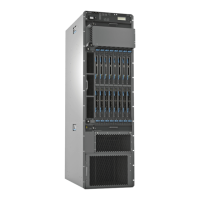loop in the cable management system. Placing fasteners on the loop helps to maintain
its shape.
CAUTION: Do not let fiber-optic cable hang free from the connector. Do
not allow fastened loops of cable to dangle, which stresses the cable at
the fastening point.
CAUTION: Avoid bending fiber-optic cable beyond its minimum bend
radius.An arc smaller than a few inches in diametercan damage the cable
and cause problems that are difficult to diagnose.
8. Use one of the following methods to bring the PIC online:
•
Press the PIC offline/online button until the PIC LED lights green.
•
Issue the following CLI command:
user@host> request chassis pic fpc-slot fpc-slot pic-slot pic-slot online
For more information about the command, see the Junos OS System Basics and
Services Command Reference.
The normal functioning status LED confirms that the PIC is online. You can also verify
correct PIC functioning by issuing the show chassis fpc pic-status command.
Related
Documentation
PTX Series PIC Description on page 36•
• Troubleshooting the PTX5000 PICs and PIC Cables on page 147
• Preventing Electrostatic Discharge Damage to a PTX5000 Packet Transport Switch
on page 222
Replacing a PTX5000 PIC Cable
1.
Removing a PTX5000 PIC Cable on page 181
2.
Installing a PTX5000 PIC Cable on page 182
Removing a PTX5000 PIC Cable
Removing and installing PIC cables does not affect packet transport switch function,
except that a PIC does not receive or transmit data while its cable is disconnected. To
remove a PIC cable:
1. Have ready a rubber safety cap for each fiber-optic cable and fiber-optic transceiver.
2. If removing all cables connected to the PIC, use one of the following methods to take
the PIC offline:
•
Press its online/offline button.
•
Issue the following CLI command:
181Copyright © 2012, Juniper Networks, Inc.
Chapter 15: Replacing Packet Transport Switch Hardware Components

